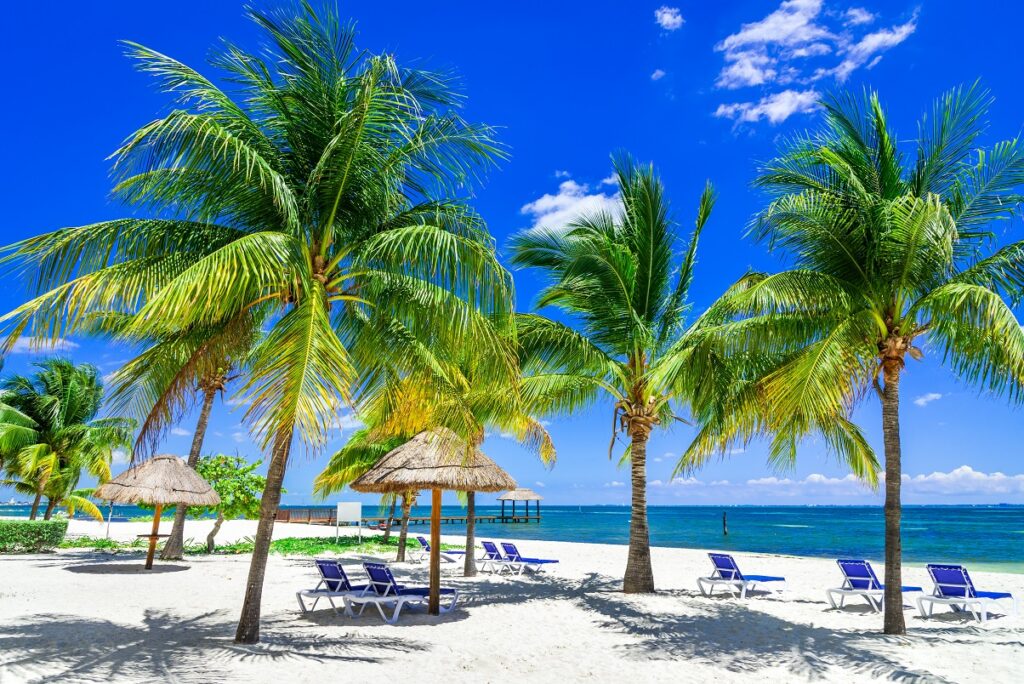
CANCUN, QUINTANA ROO
Cancún (/kænˈkuːn/ or /kɑːn-/; Spanish pronunciation: [kaŋˈkun] pronuncion is a city in southeast Mexico on the northeast coast of the Yucatán Peninsula in the Mexican state of Quintana Roo. It is a significant tourist destination in Mexico and the seat of the municipality of Benito Juárez. The city is on the Caribbean Sea and is one of Mexico’s easternmost points.
Etymology and coat of arms
There are two possible translations of Cancún, based on the Mayan pronunciation kaan kun. The first translation is “nest of snakes”. The second version and less accepted is “place of the golden snake”.
The shield of the municipality of Benito Juárez, which represents the city of Cancún, was designed by the Mexican-American artist Joe Vera. It is divided into three parts: the color blue symbolises the Caribbean Sea, the yellow the sand and the red the sun with its rays.
Cancún is just north of Mexico’s Caribbean coast resort band known as the Riviera Maya. In older English-language documents, the city’s name is sometimes spelled “Cancoon”, an attempt to convey the sound of the name.
As documented in the earliest colonial sources, Cancún was originally known to its Maya inhabitants as Nizuc (Yucatec Maya [niʔ suʔuk]) meaning either “promontory” or “point of grass”.
In the years after the Conquest, much of the Maya population died off or left as a result of disease, warfare, piracy, and famines, leaving only small settlements on Isla Mujeres and Cozumel Island.
The name Cancún, Cancum or Cankun first appears on 18th-century maps.
The meaning of Cancún is unknown, and it is also unknown whether the name is of Maya origin. If it is of Maya origin, possible translations include “Place/Seat/Throne of the Snake” or “Enchanted Snake”. Snake iconography was prevalent at the pre-Columbian site of Nizuc.
When development of the area as a resort was started on January 23, 1970, Isla Cancún had only three residents, all caretakers of the coconut plantation of Don José de Jesús Lima Gutiérrez, who lived on Isla Mujeres. Some 117 people lived in nearby Puerto Juárez, a fishing village and military base.
Due to the reluctance of investors to gamble on an unknown area, the Mexican federal government financed the first nine hotels.
The first financed hotel was a Hyatt, Cancún Caribe, but the first hotel built was the Playa Blanca, which later became a Blue Bay hotel. It is now named Temptation Resort. At the time it was an elite destination, famous for its virgin white sand beaches.
The city began as a tourism project in 1974 as an Integrally Planned Center, a pioneer of FONATUR (Fondo Nacional de Fomento al Turismo, National Fund for Tourism Development), formerly known as INFRATUR. Since then, it has undergone a comprehensive transformation from being a fisherman’s island surrounded by virgin forest and undiscovered shores to being one of the two most well-known Mexican resorts, along with Acapulco. The World Tourism Organization (WTO), through its foundation UNWTO-Themis, awarded the Best of the Best award “for excellence and good governance” to the Trust for Tourism Promotion of Cancún on February 3, 2007. This award ensured Cancún the ongoing support of the Department of Education and Knowledge Management of the WTO.
Most ‘Cancunenses’ are from Yucatán and other Mexican states. A growing number are from the rest of the Americas and Europe. The municipal authorities have struggled to provide public services for the constant influx of people, as well as limiting squatters and irregular developments, which now occupy an estimated ten to fifteen percent of the mainland area on the fringes of the city.
The 2010 United Nations Climate Change Conference was held in Cancún from November 29 to December 10 of that year.
